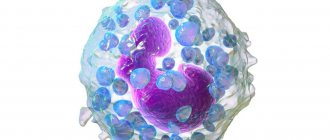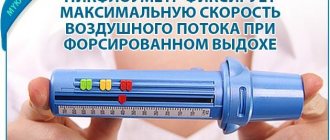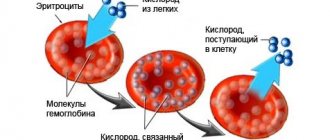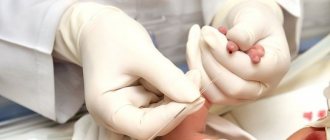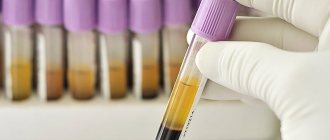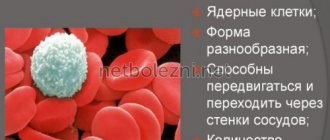Lymphocytes are the main cells of the immune system, which are responsible for all of our internal defenses. If we decipher the word “lymphocytes” itself, it consists of two ancient Greek words – lymph and cytos. Lymph is a container, and cytos is a cell. Lymphocytes are representatives of white blood cells, which are the main cells of the immune system. From the moment they appear in the bone marrow until they must perform their particularly important function - to stand on our internal genetic purity - a certain period of time passes.
Read more about blood tests in our article
“Hematological tests: norms and interpretation of results.”
Types of lymphocytes
When the bone marrow releases a young lymphocyte into the bloodstream, it is not yet ready to perform its most delicate functions. Some of the young cells, lymphocytes, go to the thymus, or thymus gland, and there they must undergo maturation or “training.” What does "training" mean? A young lymphocyte must become familiar with the antigens that our body has encountered throughout life, starting from prenatal development. After maturation, thymus-dependent lymphocytes (T-lymphocytes) will begin to recognize antigens, understand that these are genetic strangers and will be ready to carry out their tasks.
T lymphocytes.
There are several types of T-lymphocytes.
The first type is killer T-cells. Killers are killers. They are the ones who are sharpened to recognize a genetic stranger and try to kill him right away.
The second type is T-helper cells, or helper cells. It is the T helper cells that will include the following cells that will produce antibodies or protective protein structures for us.
The third type is T-suppressors - those cells that will stop the immune response.
And so, if a genetic alien enters the human body, the killers will be the first to recognize it and will try to kill it immediately. What can act as a genetic stranger? These are viruses, bacteria, parasites, fungi, and cancer cells that can appear every second. Cells of the body in which a failure occurred at the genetic level. If a person has food intolerance, then, unfortunately, they can also turn into genetic strangers and also deplete the lymphocyte component of the immune system.
B lymphocytes
These are also lymphocytes, which, having emerged young from the bone marrow into the bloodstream, rush to the lymph nodes, to the spleen, or to the liver, where they will also mature. The main function of B cells is to produce representatives of humoral immunity, or blood immunity, for us. It is the B cells that will produce antibodies that will fight viruses, bacteria, and other genetic invaders.
NK cells or natural killer cells.
This is a group of cells that will primarily be focused on protecting us from cancer. First of all, natural killers will work in antitumor defense and antiparasitic defense. NK cells are the main types of lymphocytes.
How to treat elevated lymphocytes
There is no treatment as such, since we are not talking about a separate disease, but about a symptom of some disease. Therefore, to normalize the level of lymphocytes, it is necessary to combat the root cause of their increase.
Most often, treatment for women comes down to the following procedures:
- If the cause is the use of certain medications, then they are replaced with analogues
- In case of poisoning, therapy is carried out to eliminate intoxication.
- In the case of infectious and inflammatory lesions, drug therapy is carried out aimed at eliminating the pathological focus.
- Following a protein diet.
A low level of lymphocytes in the blood is possible with the following treatment methods:
- When the bone marrow is irradiated with radiation, lymphocytes will decrease in number, like other blood sprouts.
- With chemotherapy, lymphopenia in this case is a side reaction.
- The use of cytostatics determines the successful engraftment of transplanted organs and tissues, and also suppresses immunity with a critical effect on lymphocytes as its main link.
- Sometimes lymphopenia develops as a side effect of sulfonamide therapy, even with an initially high concentration of immune cells in the blood.
- The number of lymphocytes drops with any severe viral or bacterial infection, when the immune potential of the human body is completely depleted.
A person who wants to normalize the level of lymphocytes in the blood should tell the doctor about his lifestyle.
Perhaps he is too often exposed to various stressful situations or excessive physical activity (this often happens with professional athletes or people who are engaged in hard work).
At the same time, his sleep may be insufficient, which does not allow the subject’s body to recover.
He may not be eating properly or adequately. In this case, it is urgent to change your lifestyle and diet.
It takes eight hours for a person to get enough sleep.
The food consumed by a person must be balanced and fully satisfy his needs
You shouldn’t get nervous over trifles, and in general it’s better to avoid conflict situations that can lead to emotional breakdowns.
It is also advisable to limit physical activity (hard work, intense training for athletes).
If we are talking about women, then pregnancy may be the cause of increased white blood cells. In pregnant women, the immune system is greatly enhanced. There is nothing wrong with this, and in such situations there is no need for treatment.
Reducing the level of lymphocytes in women using folk remedies
The listed traditional medicines strengthen the immune system and have a positive effect on the circulatory system.
They should not be taken only if you are allergic to the components.
Folk remedies quickly cope with the physiological surge in the increase in lymphocytes in women.
If you have serious illnesses, consult a doctor and undergo comprehensive treatment under his supervision.
To normalize hematopoiesis and reduce the level of leukocytes and lymphocytes, use the following folk remedies:
Horsetail
Dry herb (15 g) pour a glass of boiling water, cover with a lid and leave overnight.
Strain the infusion.
Take 20 ml three times a day for a month.
Blackthorn berries
Pour a kilogram of thorn fruit into 400 ml of water and mash with a masher.
Leave to sit for 24 hours, then cook for 10 minutes.
Cool the product to room temperature and strain.
Add honey or sugar, drink 50 ml three times a day before meals.
Course - 2-3 weeks.
Lime tea.
Brew dry or fresh flowers and young linden leaves. Drink a glass of tea twice a day.
Sweeten the drink with sugar or honey.
Tea made from berries and birch buds.
Take a teaspoon each of strawberries, lingonberries and birch blossom. Place ingredients in boiling water (250 ml).
Cook for 7 minutes, then remove from heat and leave covered for 15 minutes.
Divide the serving into three times and drink after meals. Add sugar or honey if desired.
Juices
Freshly squeezed juice from apples, carrots, onions and beets helps. However, such juices should not be consumed by people suffering from gastrointestinal disorders.
Tea
Chamomile tea is a folk remedy against lymphocytosis.
Beetroot infusion
A popular remedy is beetroot infusion. The beets are cut into small slices and filled with 1.5 liters of hot water.
Add one teaspoon of table salt and a little honey.
The infusion must be consumed for 2 weeks.
Norm of lymphocytes in the blood
Unfortunately, there are often situations when lymphocytes in the blood can deviate from the norm - increase or decrease. This can happen in various situations. Before we talk about when the number of lymphocytes changes in the blood, we need to talk about how much is their normal component.
If we talk about cell clones, then:
T cells make up 75% of the total number of lymphocytes;
B cells about 15%;
Natural killers are about 10%.
And speaking about the norms of lymphocytes, it must be said that at different periods of a person’s life the norms differ.
Lymphocytes begin to be produced by the bone marrow already in utero, and this process continues throughout life. The lifespan of these cells also varies - from several months to sixty years. And these will all be lymphocytes.
Immunophenotyping of peripheral blood cells (Extended immunogram)
The extended immunogram study includes the determination of: 1. CD typing of peripheral blood lymphocytes: CD3, CD3/4, CD3/8, CD19, CD16/56, CD3/16/56, CD3/HLA-DR, CD3/25, CD3 /95, CD3/4/95, CD3/8/95, CD3/8/38; 2. Leukocyte-T-LF index; 3.Immunoregulatory index.General information about the study
In the modern understanding, a person’s immune status is a set of laboratory indicators that characterize the quantitative and functional activity of cells of the immune system at a given time. The assessment of immune status is carried out using an immunological laboratory examination - an immunogram. A blood immunogram does not selectively reflect the state of a pathologically altered organ or system, but allows one to evaluate the immune system as a whole (the total effect of changes in the activity of the immune system in response to a foreign antigen).
The main subpopulations of lymphocytes: 1. T-lymphocytes - lymphocytes, the maturation of which occurs in the thymus (hence their name). They control the work of B lymphocytes responsible for the formation of antibodies, i.e., for the humoral immune response. 2. T-helpers, Th (from English to help - help) - a type of T-lymphocytes, carry on their surface structures that facilitate the recognition of antigens presented by auxiliary cells, participate in the regulation of the immune response, producing various cytokines. 3. Cytotoxic T cells - recognize antigen fragments on the surface of target cells, orient their granules towards the target and release their contents in the area of contact with it. Moreover, some cytokines are a signal of death (apoptosis type) for target cells. 4.B-lymphocytes (from the Latin “bursa” - a bursa named after the bursa of Fabricius, in which these lymphocytes mature in birds) develop in the lymph nodes and other peripheral organs of the lymphoid system. On the surface, these cells carry immunoglobulins that function as receptors for antigens. In response to interaction with an antigen, B lymphocytes respond by dividing and differentiating into plasma cells that produce antibodies, through which humoral immunity is provided. 5.NK cells (natural killer cells) or natural killer cells with natural, non-immune cytotoxic activity towards neoplastically altered target cells that are neither mature T- or B-lymphocytes, nor monocytes. 6.T-NK cells (NKT) – cells with natural non-immune killer activity, having characteristics of T-lymphocytes. 7. Activated lymphocytes. HLA-DR is one of the MHC class II antigens (major histocompatibility complex) involved in the presentation of potentially foreign antigens, which is necessary for the formation of an adequate immune response. In immunophenotyping it can be used as a marker of activated cells. CD3+HLA-DR+ are cells that are mature activated human T lymphocytes. CD3-HLA-DR+ are activated non-T lymphocyte cells (B lymphocytes and activated EK). 8. The CD95+ receptor is one of the apoptosis receptors. Apoptosis is a complex biological process necessary to remove damaged, old and infected cells from the body. The CD95 receptor is expressed on all cells of the immune system. It plays an important role in controlling the functioning of the immune system, as it is one of the receptors for apoptosis. Its expression on cells determines the cells' readiness for apoptosis. Determination of CD95 expression has prognostic significance in myelo- and lymphoproliferative diseases.
Determination of the cellular composition (immunophenotyping) of blood lymphocytes - the main component in assessing the immune status - is performed by flow cytometry. Immunophenotyping is a characteristic of cells obtained using monoclonal antibodies or any other probes that make it possible to judge their type and functional state by the presence of a particular set of cellular markers. Immunophenotyping of leukocytes involves detecting differentiation markers, or CD antigens, on their surface. Leukocytes express a range of surface and cytoplasmic antigens unique to their subpopulation and developmental stage. CD antigens (cluster of differentiation antigens) are antigens on the surface of cells, markers that distinguish one cell type from another. The differentiations of these antigens have been studied and standardized, and they are assigned specific numbers. CDs can be recognized using appropriate monoclonal antibodies. Using fluorescently labeled monoclonal antibodies that bind to specific CDs, it is possible to calculate the content of lymphocytes belonging to subpopulations of different functions or developmental stages using flow cytometry. Flow cytometry is based on the photometric and fluorescence measurement of individual cells crossing, one after another, along with a fluid stream, a beam of monochromatic light, usually laser light. The method allows not only to determine the quantitative ratio of the main populations of lymphocytes: - T-lymphocytes (CD3+CD19-), - T-helpers/inducers (CD3+CD4+CD45+), - T-cytotoxic lymphocytes (T-CTL) (CD3+CD8 +CD45+), - true natural killers (NK cells) (CD3-CD56+CD45+), - B lymphocytes (CD19+CD3-), but also to evaluate small cell populations, as well as study their functional activity: - T - lymphocytes expressing NK cell markers (T-NK cells) (CD3+CD56+CD45+), - NK cells expressing the alpha chain of the CD8 antigen (CD3-CD8+CD45+), - activated B lymphocytes (CD3- CD25+CD45+), - activated T lymphocytes (CD3+HLA-DR+CD45+) and activated cytotoxic lymphocytes (CD8+HLA-DR+CD45+), - B lymphocytes and activated NK cells (CD3-HLA-DR+CD45+ ), - activated T-lymphocytes expressing the alpha chain of the IL-2 receptor (CD3+CD25+CD45+), - regulatory T-helper cells (CD4+CD25brightCD127negCD45+), performing an immunosuppressive function.
Such a comprehensive study of the cellular composition of lymphocytes, together with the results of other tests included in the study, allows us to establish more subtle mechanisms of immunological disorders, clarify the degree and depth of damage to the immune system and select a drug for subsequent adequate immunocorrective therapy, evaluate the effectiveness of the treatment, and give a prognosis of the disease .
The immunogram also includes the determination of the leukocyte-T-lymphocyte index and the immunoregulatory index. Leukocyte-T-lymphocyte index - reflects the ratio of the total number of leukocytes to the T-lymphocyte cell unit. It is a relative indicator with an indicative value. Its slight increase or decrease does not have independent diagnostic significance, since a deviation of the index can be observed with normal, but close to the normal limits, indicators of the number of T-lymphocytes and/or leukocytes. However, changes in the index force the clinician to focus on the reasons for the deviation of the specified index.
The immunoregulatory index CD4/CD8 - as the name implies, reflects the ratio of CD4+ cells (T-helpers) to CD8+ cells (T-cytotoxic cells). It is a relative indicator with an indicative value. Its slight increase or decrease does not have an independent diagnostic value, since the deviation is normal, but close to the normal limits, in the number of CD4+ cells and/or CD8+ cells. However, changes in the index force the clinician to focus on the reasons for the deviation of the specified index.
Indications for prescribing the study:
The study is recommended for a comprehensive examination of patients at risk for the four main immunopathological syndromes. 1. With an infectious syndrome: - frequent acute respiratory viral infections, chronic infections of the ENT organs (purulent sinusitis, otitis, periodic lymphadenitis, pneumonia with a tendency to recur, bronchopleuropneumonia); - bacterial infections of the skin and subcutaneous tissue (pyoderma, furunculosis, abscesses, phlegmon, septic granulomas, recurrent paraproctitis in adults); - urogenital infections; - fungal infections of the skin and mucous membranes, candidiasis, parasitic infestations; - recurrent herpes of various localizations; - gastroenteropathy with chronic diarrhea of unknown etiology, dysbacteriosis; - prolonged low-grade fever, fever of unknown etiology; - generalized infections (sepsis, purulent meningitis). 2. With allergic (atopic) syndrome: - atopic dermatitis; — neurodermatitis; - eczema with an infectious component; - severe atopic bronchial asthma, hay fever, chronic asthmatic bronchitis. 3. With autoimmune syndrome: - rheumatoid arthritis; - multiple sclerosis; — diffuse connective tissue diseases (systemic lupus erythematosus, scleroderma, dermatomyositis); — autoimmune thyroiditis; - nonspecific ulcerative colitis. 4. With immunoproliferative syndrome: - tumor processes in the immune system (lymphomas, Hodgkin's disease, acute and chronic lymphocytic leukemia, Kaposi's sarcoma).
The number of lymphocytes in the blood during pregnancy
Accordingly, there are periods of life, especially in the female body, when the concentration of lymphocytes will also decrease. First of all, I mean pregnancy. In order to prevent immunological rejection from occurring, since the fetus contains 50% of foreign cells, the body arranges everything in such a way that the production of its own lymphocytes decreases. That is why we are talking about a physiological, immunosuppressive state in women during pregnancy. There is a decrease in immunity so that the woman can safely carry the fetus.
Online consultation with infectious disease specialist, allergist-immunologist Natalia Nikolaevna Gordienko
Cost of online consultation: 3500 rubles
Online consultation
During the consultation, you will be able to voice your problem, the doctor will clarify the situation, interpret the tests, answer your questions and give the necessary recommendations.
What else is prescribed with this study?
Biochemistry 8 indicators
27.113. Venous blood 1 day
990 RUR Add to cart
HEMOSTASIOGRAM (Coagulogram)
27.4. Venous blood 1 day
RUB 2,020 Add to cart
Immune status (screening) (Phagocytic activity of leukocytes, cellular immunity, total immunoglobulin IgE, immunoglobulins IgA, IgM, IgG)
27.960. Venous blood 3 days
RUR 7,640 Add to cart
Clinical blood test with leukocyte count and ESR (with microscopy of a blood smear to detect pathological changes) (venous blood)
3.9.1. Venous blood 1 day
720 RUR Add to cart
General urine analysis
9.1. Urine 1 day
380 RUR Add to cart
Increase and decrease in lymphocytes in blood tests
And so, you and I have already understood that lymphocytes are the main cells of our immune system. And depending on how their quantity in the blood changes, changes in the blood formula will be called.
Reduced number of lymphocytes in the blood
— lymphopenia.
Increased number of lymphocytes in the blood
– lymphocytosis.
What causes our immune system and bone marrow to release increased numbers of lymphocytes into the blood? Since these are the main cells that are responsible for our genetic protection, it means that we need to understand that “not everything is in order in the state.”
I would also like to draw your attention to the fact that lymphocytosis and lymphopenia are not diseases. These are conditions of the human body in which a violent reaction occurs or does not occur in the immune system. And any change in the number of lymphocytes will always indicate that it is necessary to check what reasons led to this or that change.
general characteristics
Lymphocytes belong to the leukocyte family. These white cells, whose size does not exceed 10 microns, were discovered a long time ago. Their norm in the blood is 20-40% of the total number of leukocytes. Lymphocytes are cells, most of which are formed in the red bone marrow. They are detected during a wide variety of events occurring in the body. The functions of the smallest cells of the leukocyte family are varied.
First of all, thanks to them, the immune system learns about the penetration of pathogenic elements into the body that have a destructive effect. After receiving such information, natural protective reactions are activated. In addition, lymphocytes form an immune barrier that minimizes the risk of infection.
Under the influence of these cells, foreign tissue is rejected. In particular, this happens during transplantation. Lymphocytes also play an important role in the fight against malignant tissue degeneration in the body. They are always present during cell division, regardless of its nature: natural or pathological.
What is lymphocytosis?
The laboratory term reflects disturbances in the functioning of the body. He talks about activating defense forces to combat the invasion of alien agents:
- bacteria;
- viruses;
- protozoa;
- parasites.
Other prerequisites may be massive damage or cell death (extensive burns, necrosis), inflammatory processes, allergic reactions. Sometimes reactive immune processes are directed against the body itself (autoimmune diseases). The formation of tumors may be a prerequisite for lymphocytosis. In this case, the cells are produced, reach the pathogenic focus, but die as the destruction progresses.
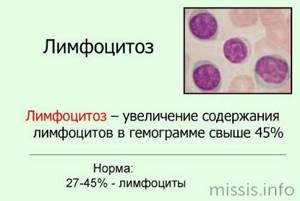
Chronic lymphocytosis can be the result of diseases of the blood or hematopoietic organs, the lymphatic system. Protective bodies do not fully undergo the process of maturation and differentiation, which is why they do not cope with their functions. To restore balance, the bone marrow produces even more cells, but this is of little benefit.
Lymphocytes can accumulate in the blood if the process of their utilization in the spleen is disrupted.
What is important is not so much the fact of deviations in the analysis as its causes. The prerequisites for a shift in the leukocyte formula should be detected as quickly as possible. If the immune system malfunctions, the risk of developing chronic infectious diseases, autoimmune attacks, and the appearance and proliferation of atypical cells increases.

References
- V. L. Bykov. Cytology and general histology. 2002.
- Khaitov, R.M. Allergology and immunology: national guide / ed. R.M. Khaitova, N.I. Ilyina. 2009.
- Afanasyev Yu.I. Histology, embryology, cytology. Textbook. Revised and expanded 6th edition. 2021.
- Immunology: structure and functions of the immune system: textbook / R. M. Khaitov. 2013.
- Immunology and allergology: a textbook for students of medical universities / ed. A. Vorobyova, A.S. Bykova, A.V. Karaulova. 2006
Diagnosis of lymphocytosis
It is impossible to accurately diagnose pathology only by the number of lymphocytes. Checking the blood condition is based on a detailed blood test.
Most often these indicators are compared
:
- Leukocytes and lymphocytes
. Their mutual increase may indicate blood cancer. With tuberculosis and some other viral infections, a low leukocyte count and a high lymphocyte count are shown; - Platelets and lymphocytes
. An increase in two indicators is observed in autoimmune diseases; - Red blood cells and lymphocytes
. The synchronous growth of these bodies occurs during infection.
